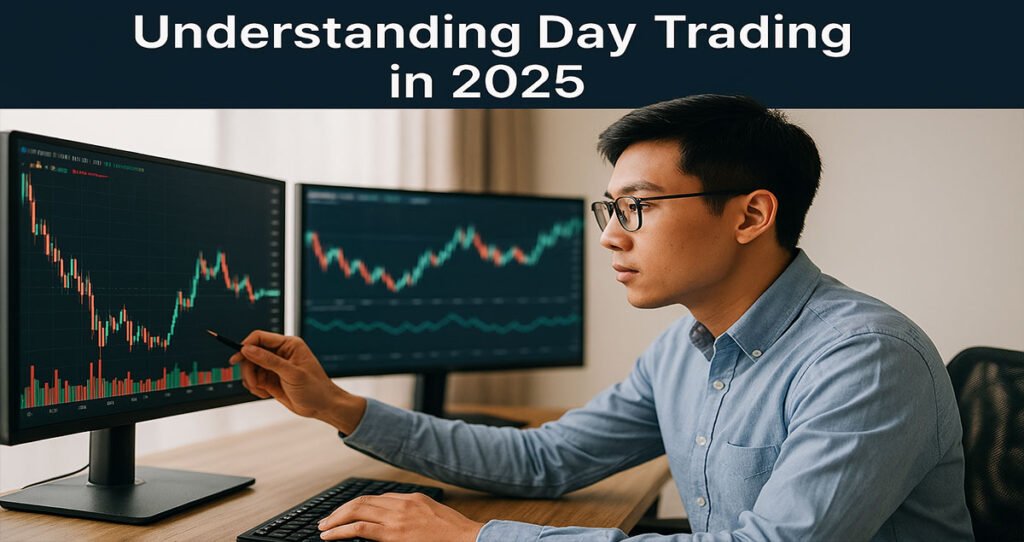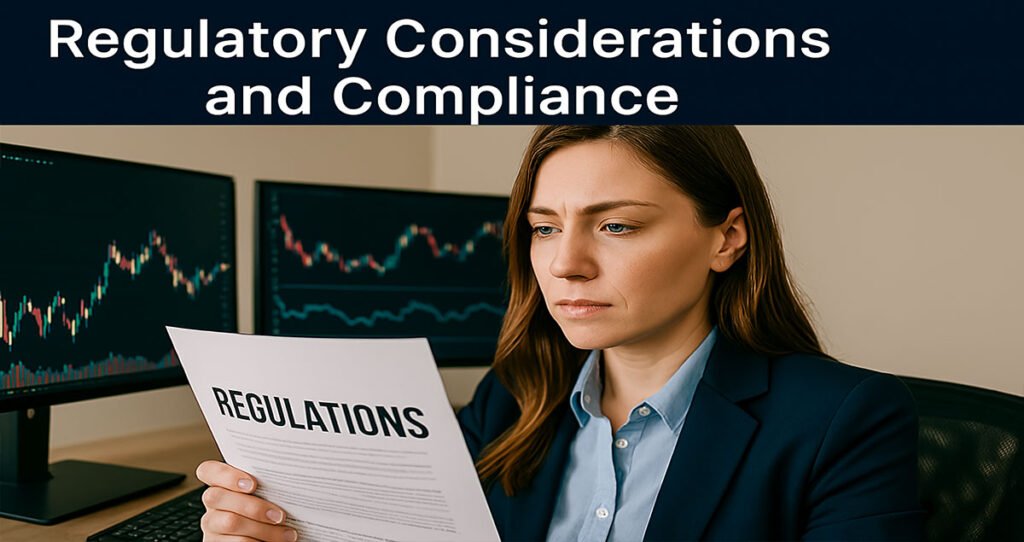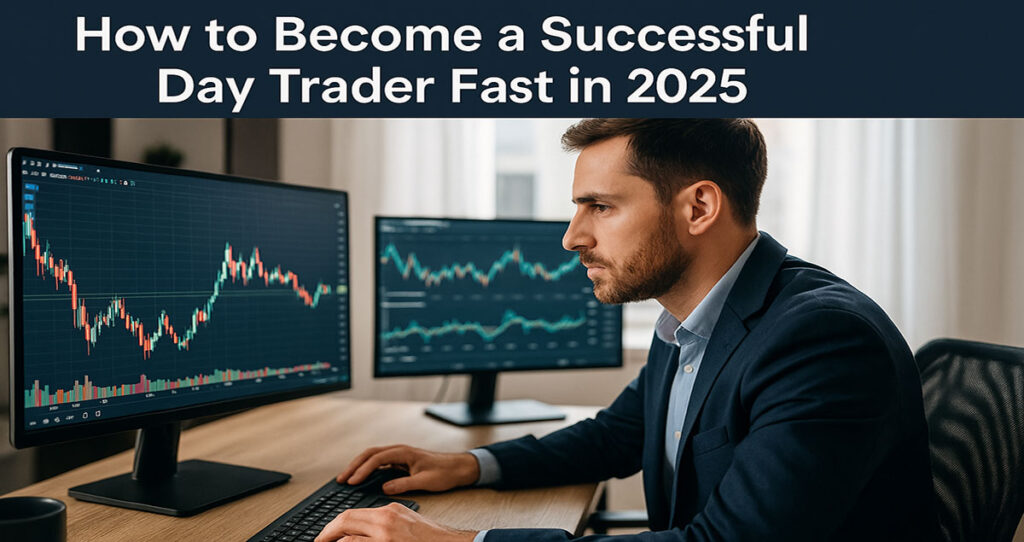You need to master basic trading concepts, use advanced systems, follow risk control measures, and keep up with growing market changes to succeed as a day trader in 2025. The guide covers all the steps and provides detailed action points to help you improve your day trading skills.
Introduction
Understanding Day Trading in 2025
Day trading in the year 2025 involves using modern tools together with classic trading methods. Because of artificial intelligence, machine learning, and real-time data analytics, traders today find it easier than before to make decisions and carry out trades quickly. Even so, the basic goal is to catch small market shifts to make profits each day as you trade.

These days, a trader has to manage a tough environment full of rapid updates, heightened trading movement, and plenty of instruments for trading. Getting good results here means combining strong technical skills, careful strategy, and good emotional control.
The Evolution of Day Trading: 2020 to 2025
These past five years have brought big changes to the world of day trading. Because of democratization, trading platforms are open to more individuals than before. Also, because AI and algorithmic trading are used more, the competition has grown, prompting industries to use data and analysis to succeed.
Key developments include:
- Increased Accessibility: Trading is now within reach of more people because of mobile apps and intuitive websites.
- Advanced Analytical Tools: AI and real-time analysis are now important parts of trading systems.
- Diverse Trading Instruments: There are more kinds of tradable assets now, which include cryptocurrencies, ETFs, and derivatives.
- Regulatory Changes: Authorities and banks have introduced new rules to safeguard the market and look out for retail investors.
Anyone hoping to be a successful day trader in 2025 must understand these changes.
Setting the Foundation
Essential Skills for Aspiring Day Traders
A person starting in day trading must have a combination of strong analytical skills and good emotional intelligence. Key skills include:
- Technical Analysis: Understanding charts, finding regularities, and checking indicators to predict prices.
- Risk Management: Being able to use strategies, for example, stop-loss orders and adjusting position size to limit possible losses.
- Decision-Making Under Pressure: Responding quickly and correctly to changes in a market that acts fast.
- Emotional Control: Keeping a level head when things in the market change quickly to stop making rushed decisions.
- Continuous Learning: Following market changes, news, and the latest methods used in trading.
Working on these abilities sets you up for a positive trading experience.
Importance of Financial Literacy and Market Understanding
Good trading requires you to be financially literate. A good grasp of market workings, important economic data, and the tools traders use supports them in making wise decisions. Priority aspects to pay attention to are:
- Market Structures: Getting to know how stock exchanges, the forex market, and cryptocurrency platforms are managed.
- Economic Indicators: Using statistics such as growth in GDP, unemployment, and inflation to try to predict the movement of the market.
- Financial Instruments: Knowledge of stocks, options, futures, and ETFs.
- Regulatory Environment: Knowing the laws and guidelines that direct any trading to avoid getting into trouble with the law.
Getting better at financial literacy helps a trader handle the markets well.
Choosing the Right Trading Platform
Features to Look for in 2025 Trading Platforms
It is very important to choose a suitable trading platform to execute deals and use helpful tools. Essential features to consider include:

- User Interface: A simple and flexible environment that helps users move through easily and place orders effortlessly.
- Analytical Tools: Ability to use advanced charts, various technical indicators, and get real-time updates.
- Order Types: There is support for placing market, limit, stop-loss, and trailing stop orders.
- Security Measures: High-quality strategies in place to protect sensitive data and finances.
- Customer Support: Quickly helping customers with questions or issues about the technology.
- Educational Resources: Tutorials, webinars, and articles to help with ongoing learning are available.
Going over these features helps a trader find a platform that addresses their needs and desired goals.
Top Recommended Platforms for Beginners
Hotline providers and simple, user-friendly tools are best for people who are new to the field. Platforms that experts agree are among the best in 2025 are:
- Platform A: Thanks to the easy-to-use interface and plentiful educational tools, anyone new to programming should try this.
- Platform B: Offers powerful analytical features and lets users trade in a practice account.
- Platform C: Makes it possible to trade many different markets and types of financial instruments.
Selecting the right platform matters a lot for how quickly a trader learns and what success they achieve.
Developing a Trading Strategy
Popular Day Trading Strategies in 2025
Using a standard trading strategy is important for both staying focused and controlling risks. Planning methods expected to be popular in 2025 are:
- Scalping: Focuses on making many small transactions to earn profits from small changes in prices.
- Momentum Trading: Watches for stocks that are trending strongly and have a lot of trading volume.
- Breakout Trading: Watch for stocks that have moved past their support or resistance line, believing this could bring major price changes.
- Reversal Trading: Looks for opportunities where a stock’s price is likely to change direction so that traders can get in early.
- News-Based Trading: Uses market movements that happen after major news is released or big economic updates.
Tailoring Strategies to Individual Risk Profiles
All day traders are different, and so what is effective for one might not be for another. In 2025, people who make money trading modify popular methods to suit what they want, what they are comfortable with, and how the markets behave. Fitting your plan is much like making a suit fit – it should be comfortable and appropriate for you.
Below are some suggestions for how new traders can build their strategies:
- Define Risk Appetite: Know the amount you are willing to lose for each trade. Some people like to stake a lot to win big, but not everyone does. Your risk tolerance helps decide if you prefer rapid scalping or placing trades following trends.
- Time Commitment: Can you dedicate several hours a day to the markets, or only brief periods? Scalpers need to be glued to the screen, while swing traders can monitor positions over a longer timeframe.
- Financial Goals: Are you investing just for additional cash flow, or do you aim to work as a trader all the time? You need your strategy to be in line with your money goals in order to prevent irrational trading.
- Asset Preference: Stocks are often the specialty of some traders, but others prefer forex, futures, or crypto. Since each market is different, your strategy ought to fit the features of the one you trade in.
Example Strategy Customization Table:
| Trader Type | Risk Tolerance | Time Available | Preferred Market | Strategy Suggestion |
| Conservative | Low | 1-2 hours/day | Blue-chip Stocks | Breakout or Swing Trading |
| Aggressive | High | Full-time | Cryptocurrencies | Scalping or Momentum |
| Balanced | Moderate | 3-4 hours/day | Forex | Trend-following |
Successful traders in 2025 rely on testing and refining these personalized strategies through backtesting and demo trading. That’s how they transform theory into real-world performance.
Risk Management and Capital Preservation
Setting Stop-Loss and Take-Profit Levels
One of the most important rules in trading is this: protect your capital. This is the main reason stop-loss and take-profit orders are developed for. These are your “seat belts” in the chaotic world of financial markets.

- Stop-Loss Orders
A stop-loss limits potential losses by automatically closing a trade when the asset drops to a certain price. This prevents devastating losses, especially in fast-moving markets. - Take-Profit Orders
This is the flip side—locking in gains. When your target profit is reached, the trade closes, ensuring you walk away with a win.
Best Practices for Using Stop-Loss & Take-Profit:
- Don’t Place Arbitrarily: Avoid setting your stop-loss at random price levels. Use support and resistance lines or percentage-based thresholds.
- Use Risk-to-Reward Ratios: A typical ratio is 1:2 or 1:3, meaning you’re willing to risk $1 to make $2 or $3.
- Stick to the Plan: Once your order is in place, don’t move it unless your trade setup justifies it.
- Avoid Tight Stops on Volatile Assets: In highly volatile markets like crypto, give your trade enough “breathing room.”
Risk-to-Reward Table Example:
| Trade Setup | Stop-Loss (Risk) | Take-Profit (Reward) | Risk/Reward Ratio |
| Trade A | $50 | $150 | 1:3 |
| Trade B | $100 | $100 | 1:1 |
| Trade C | $20 | $60 | 1:3 |
A strong risk management framework is what separates amateurs from professionals. It allows you to survive losing streaks and capitalize on winning ones.
Diversification and Position Sizing
Imagine putting all your money into a single stock that tanks overnight. This kind of situation is the trader’s worst nightmare. Because of this, a sound trading plan must always include proper diversification and the right way to use position sizes.
- Diversification
This is about spreading your risk across different assets. Even within day trading, don’t just trade one sector or instrument. For example, you could day trade a mix of tech stocks, forex pairs, and crypto tokens. The key is to avoid overexposure to a single market event. - Position Sizing
How much of your account should go into a single trade? Use the 1-2% rule: never risk more than 2% of your account on any one trade. Because of this, you can keep going during periods when you are not winning.
Advantages of Proper Diversification:
- Reduces emotional trading
- Smoothens your equity curve
- Limits drawdowns
Think of it this way: Don’t own only one kind of investment and don’t buy too many types, either. It is very important to achieve balance.
Leveraging Technology and Tools
Utilizing AI and Machine Learning in Trading
In the year 2025, artificial intelligence (AI) is no longer just talked about—it transforms the world of day trading. Some traders now use AI and machine learning to spot trends, make automatic trades, and improve their performance. It’s as if you had an intelligent ally who keeps working, never gets tired, and analyzes data faster than anyone else.
Day trading is being transformed by the application of AI in many ways.
- Predictive Analytics
AI algorithms can analyze historical data and current market conditions to forecast price movements with surprising accuracy. While no system is foolproof, these tools help traders identify high-probability setups. - Trade Automation: Traders can set up AI bots to make trades when specific indicators happen. Because emotional bias is removed, the actions are executed consistently.
- Sentiment Analysis: AI tools now scan social media, news headlines, and financial reports in real-time to gauge market sentiment. This allows traders to react quickly to unexpected developments.
- Risk Management Optimization: AI can recommend ideal stop-loss and take-profit levels based on historical volatility and recent price action.
Top AI Tools Used by Traders in 2025:
| Tool Name | Key Feature | Use Case |
| TradeGPT | Predictive models for price trends | Set up confirmation and forecasting |
| AlgoEdge AI | Auto-execution based on custom rules | Automated strategy execution |
| Sentimind | News and sentiment scanning | Pre-trade sentiment analysis |
| RiskMate ML | Risk-adjusted position sizing | Dynamic portfolio management |
Using AI tools might look overwhelming in the beginning, but now many sites have easy-to-use setups. To compete now, you need to be skilled with these tools instead of just choosing to learn them.
Importance of Real-Time Data and Analytics
In day trading, timing is everything. And the difference between profit and loss often comes down to how fast a trader reacts to market changes. So, for any business to succeed in 2025, it must use real-time analytics.
Real-time data gives you up-to-the-second updates on:
- Price Changes
- Volume Spikes
- Order Book Movements
- Market News
But raw data alone isn’t enough. You need real-time analytics tools that process this data instantly and convert it into actionable insights.
Benefits of Real-Time Analytics:
- Faster Decisions: You can act before the market fully reacts to news or technical triggers.
- Better Trade Entries and Exits: Accurate, up-to-date data helps pinpoint optimal trade times.
- Increased Confidence: Backed by data, you’re less likely to second-guess yourself.
Real-Time Tools to Consider:
- In level II, you can see the depth of market (DOM) and watch goings-on at the bid and ask sides.
- News Aggregators: Stream live financial news relevant to your watchlist.
- Economic Calendar Alerts: Notify you about high-impact events like interest rate announcements.
- Custom Dashboards: Display your chosen indicators, price action, and trade history in one place.
The faster and smarter you can interpret data, the better your edge as a day trader. In 2025, traders who ignore real-time analytics are driving blind on a racetrack.
Continuous Learning and Adaptation
Staying Updated with Market News and Trends
The financial markets are always changing. Something that achieved results in the past may not be successful going forward. That’s why successful day traders in 2025 stay in learning mode. They follow news, track market trends, and adapt constantly.

Here’s how traders stay informed:
- Financial News Outlets: Subscribe to Bloomberg, CNBC, Reuters, or MarketWatch to stay updated on economic indicators, geopolitical events, and corporate earnings.
- Economic Calendars: Use tools like Investing.com or ForexFactory to track important data releases (e.g., Fed rate decisions, CPI reports).
- Social Media & Forums: Platforms like X (Twitter), Reddit (e.g., r/Daytrading), and Discord groups can offer early market buzz and insights from peers.
- Trend Tracking: Monitor trending sectors or stocks (e.g., AI, green energy, biotech) using tools like TradingView’s screener or Stocktwits sentiment feeds.
Tips to Stay Ahead of Trends:
- Read a summary newsletter each morning before markets open
- Use keyword alerts (e.g., “earnings miss,” “merger,” “regulatory approval”)
- Study successful traders’ strategies during trending markets.
. - Keep a “market mood” journal to track sentiment shifts over time
Markets reward the prepared. Staying informed helps you anticipate rather than react, and in trading, anticipation means opportunity.
Participating in Trading Communities and Forums
Trading can be a lonely game. But it doesn’t have to be. Joining a community of like-minded traders can be a game-changer, especially for those just starting.
Why Trading Communities Matter:
- Learning from Others
Forums and groups are goldmines for strategy tips, technical insights, and real-time trade ideas. - Getting Feedback
Share your trade setups or trading journal and get constructive criticism. - Accountability
Being part of a community can motivate you to stay disciplined, consistent, and committed. - Emotional Support
Everyone hits a losing streak now and then. Talking to other traders helps reduce stress and boosts morale.
Top Trading Communities in 2025:
| Platform | Features | Best For |
| Discord Groups | Real-time chats, voice calls, and trade alerts | Beginner and intermediate traders |
| Reddit (r/Daytrading) | Strategy sharing, news, memes, AMA’s | Community-driven insights |
| TradingView Social | Public idea sharing, comments, and analysis | Strategy discussions and charts |
| Twitter/X Finance | Instant news, influencer analysis | Fast updates and big moves |
Participating in these communities is like being on a virtual trading floor, without the noise and chaos. You get exposure to diverse strategies and real-time feedback, which helps sharpen your skills faster.
Psychological Aspects of Day Trading
Managing Emotions and Avoiding Impulsive Decisions
The biggest threat to a day trader’s success? It’s not the market. It’s their own emotions. In 2025, with faster markets and constant information overload, emotional control is more crucial than ever. Successful traders know that their biggest asset is not just their strategy—it’s their state of mind.
Common Emotional Pitfalls:
- Fear of Missing Out (FOMO): Jumping into trades without confirmation just because others are making moves.
- Greed: Overtrading or staying in a winning trade too long, hoping for bigger gains.
- Revenge Trading: Trying to win back a loss by entering a new trade immediately, often irrationally.
- Overconfidence: After a winning streak, taking bigger risks than usual without proper setups.
Practical Tips for Emotional Mastery:
- Create a Written Trading Plan: Follow it religiously. This reduces spur-of-the-moment decisions.
- Use a Timer: Take short breaks between trades to cool off and reset.
- Set Daily Loss Limits: Once hit, stop trading for the day—no exceptions.
- Practice Mindfulness: Breathing exercises or short meditation before and after trading sessions can improve focus.
Emotion vs. Outcome Table:
| Emotion | Trigger Event | Common Reaction | Healthy Response |
| FOMO | Market spike | Entering late | Wait for confirmation setup |
| Fear | Losing trade | Freezing, no reentry | Review strategy, adjust size |
| Greed | Quick wins | Overtrading | Stick to the trade limit |
| Frustration | Missed opportunity | Impulse trade | Reassess, prepare next setup |
Remember, the market will always be there tomorrow. But if your emotions take over, your capital might not be.
Building Mental Resilience and Discipline
Mental toughness involves doing well, not just recovering after conflict. When things are tough in day trading, you need to stay firm in following your plan and not be moody with every change in the market. This is the main difference between someone who just does it for fun and a real expert.
Traits of Mentally Strong Traders:
- Consistency: They keep the same method, rules, and capital, no matter if the market is bullish or bearish.
- Self-Awareness: They notice when they feel tired, emotional, or lose concentration and pause for a while.
- Adaptability: If something does not work out, they look for a fix and do not quit.
- Patience: They look for the most promising situations before trading.
Building Trading Discipline:
- Daily Routine: Start your day with a pre-market checklist. Prepare mentally just like an athlete before a game.
- Trade Journal: Record each exchange, counting your passionate state, basis, and result. This helps identify patterns and mistakes.
- Avoid Distractions: While trading is active, behave as you would in a job by skipping social media, refraining from texts, and not multitasking.
- Reward Good Behavior: Reward yourself for obeying your principles, not only for making money.
Morning Routine for Mental Strength:
| Time | Task | Purpose |
| 7:00 AM | Light exercise or meditation | Boost focus, reduce stress |
| 7:30 AM | Review market news | Stay updated on economic events |
| 8:00 AM | Review the trading plan | Reaffirm goals and risk limits |
| 8:30 AM | Scan watchlist | Look for high-potential setups |
Improving your mental toughness is gradual, and each day spent trading will eventually make you a stronger trader.
Regulatory Considerations and Compliance
Understanding Trading Regulations in 2025
More rules and openness exist in the trading world than at any time in the past. The regulatory authorities have gotten stricter to help retail traders and ensure the market is fair. Still, this operates on a strict system, but it minimizes risks for expert traders.

Key Regulatory Areas to Know:
- Pattern Day Trader (PDT) Rule (USA): People with a margin balance below $25,000 may only trade no more than three times in a five-day time frame. This still applies to many US platforms.
- Know Your Customer (KYC): A valid identification document must be shown by all traders before they can use trading platforms.
- Anti-Money Laundering (AML): Trading platforms monitor unusual transaction behavior. Abiding by AML rules ensures your account isn’t flagged or frozen.
- Tax Regulations: Countries now require platforms to report trading profits and losses for taxation. Get it, your neighborhood assesses laws to dodge surprises.
Crypto-Specific Regulations:
- Stablecoin Oversight: Governments have imposed stricter scrutiny on stablecoins used in day trading to prevent manipulation.
- Exchange Licensing: Only regulated crypto exchanges are now allowed to operate in major countries.
Global Regulator Snapshot:
| Country | Regulator | Trading Focus |
| USA | SEC & FINRA | Stocks, options, ETFs, crypto |
| UK | FCA | Forex, crypto, CFD platforms |
| EU | ESMA | Stock and derivatives regulations |
| Australia | ASIC | Forex and CFD trading oversight |
Being compliant is part of being professional. It helps avoid legal trouble, ensures account security, and builds credibility.
Ensuring Compliance and Ethical Trading Practices
Beyond legal obligations, responsible traders also uphold ethical standards. Why? Because ethical trading builds long-term success, strengthens market trust, and contributes to your brand.
Ethical Practices Every Trader Should Follow:
- No Insider Trading: Don’t act on non-public information—it’s illegal and unethical.
- Avoid Pump and Dump Schemes: These are fraudulent manipulations and could land you in jail.
- Disclose Sponsorships or Affiliations: If you’re promoting products, be transparent.
- Respect Platform Rules: Trying to exploit platform glitches or latency can get your account banned.
Tips for Ethical and Transparent Trading:
- Use Legal Software: Avoid unregulated brokers or unlicensed trading bots.
- Don’t Mislead Others: If you’re sharing trades online, post actual results, not just cherry-picked winners.
- Secure Your Data: Protect login credentials and avoid phishing attempts.
Compliance Checklist for 2025:
| Task | Frequency | Why It Matters |
| Update KYC documents | Annually | Avoid account suspensions |
| Review tax obligations | Quarterly | Prevent penalties and audits |
| Check platform terms & updates | Monthly | Stay informed on new rules/features |
| Backup your trading journal/data | Weekly | Secure performance and tax records |
Indeed, when no one is observing, doing the right thing characterizes proficient trading. Ethics isn’t just good behavior—it’s good business.
Building a Sustainable Trading Routine
Structuring Your Trading Day for Maximum Efficiency
A successful day trader in 2025 doesn’t just wake up and wing it. They follow a well-structured routine that allows them to optimize every hour of the trading day. This consistency is what helps separate profitable traders from emotional, inconsistent ones.
Why a Routine Matters:
- Builds discipline and consistency
- Reduces emotional and impulsive trading
- Ensures preparation and analysis before execution
- Allows proper review and self-improvement
Sample Day Trading Routine:
| Time | Activity | Purpose |
| 6:30 AM | Wake up, light exercise, mindfulness | Prepare mentally and physically |
| 7:00 AM | Review global news and pre-market trends | Identify news catalysts and market sentiment |
| 8:00 AM | Update the watchlist and trading plan | Focus on high-potential opportunities |
| 9:30 AM | Market open, start active trading | Execute strategies and manage trades |
| 12:00 PM | Review trades, take a break | Reflect on progress and reset focus |
| 2:00 PM | Afternoon trade opportunities | Re-engage for end-of-day setups |
| 4:00 PM | Market close, log trades | Record outcomes, lessons, and insights |
Best Practices:
- Avoid multitasking—treat trading like a real job
- Prepare mentally before the open to avoid jumping into impulsive trades.
. - Use timers or alerts to limit time on screen and prevent burnout.
. - Reflect daily—even on winning days—to find areas for improvement
An organized day makes a difference, keep your intellect sharp, your exchanges keen, and your comes about steady.
Balancing Trading with Personal Life
In the pursuit of trading success, it’s easy to let personal life take a backseat. But in 2025, the most successful traders are not those glued to their screens 24/7. They understand that life outside of charts is just as important.
Signs You Need Balance:
- Constant fatigue or irritability
- Neglecting relationships or hobbies
- Trading out of boredom or loneliness
- Obsessively checking charts after hours.
Strategies to Maintain Work-Life Balance:
- Set Office Hours: Treat trading like a job. Start and stop at the same time daily.
- Take Digital Detoxes: Step away from screens on weekends or non-trading hours.
- Make Time for Relationships: Allot special time to enjoy with your family and friends.
- Pursue Hobbies: Take care of your interests, whether you enjoy music, sports, or reading.
- Stay Physically Active: Practicing a healthy exercise routine improves your thinking and ability to cope with stress.
Balance Planner Example:
| Category | Activity | Frequency |
| Physical Health | 30-minute walk/exercise | Daily |
| Mental Health | Mindfulness or journaling | Daily |
| Social Life | Family dinners, calls | Weekly |
| Recreation | Hobbies or creative time | 2-3 times per week |
Remember: success is about the long game. A burnt-out trader won’t last, but a balanced one thrives—professionally and personally.
Analyzing and Reviewing Trades
Keeping a Detailed Trading Journal
Journaling your trades makes it possible to use the most powerful tool in your trading. Rather than just recording your trades, a comprehensive trading journal acts as your mentor, counselor, and outline to success.

What to Track in a Journal:
- Entry and exit points
- Trade size and position type
- Reason for the trade (setup, signals)
- Emotions before/during/after
- Outcome (profit/loss and lessons learned)
Journal Template Example:
| Date | Symbol | Entry | Exit | Reason for Trade | P/L | Emotion | Lesson Learned |
| 04/01/2025 | AAPL | 170.25 | 171.80 | Trendline breakout | +$155 | Focused | Waited for confirmation |
| 04/02/2025 | TSLA | 710.50 | 704.10 | FOMO entry | -$320 | Anxious | Stick to the plan, avoid chasing |
Benefits of Journaling:
- Spot recurring mistakes
- Identify your strongest setups.
. - Fine-tune your strategy
- Improve emotional awareness
Spend around 10–15 minutes every day thinking about your day before going to bed. Over time, this habit compounds into exponential growth.
Learning from Past Trades to Improve Future Performance
Reviewing your trades is much the same as athletes studying their game footage. You can notice which points were effective, which ones weren’t, and which improvements you might have made. In 2025, smart traders don’t just move on—they analyze.
How to Conduct a Trade Review:
- Weekly Summary: Review total P/L, win rate, average R: R ratio.
- Top Performers: Identify trades that went well—look for setup patterns.
- Biggest Losers: Dissect what went wrong—strategy, execution, or emotions?
- Video Reviews: Record screen during trades, then watch your decision-making process.
Review Dashboard Example:
| Metric | Week 1 | Week 2 | Notes |
| Total Trades | 25 | 21 | Slight decrease (quality focus) |
| Win Rate | 64% | 58% | Dip due to 3 rushed entries |
| Avg R: R Ratio | 1:2.4 | 1:2.0 | Maintain at least 1:2 |
| Emotions Rated >7 | 5 trades | 2 trades | More control and focus noted |
Such insights help you decide more effectively in the future. Looking at your past is something you need to do.
Networking and Mentorship
Finding and Learning from Experienced Traders
Even the most independent traders can benefit a lot from learning from people who have done this before. Day traders rely on mentorship and networking in 2025 to prevent expensive mistakes and build their progress speedily.
Where to Find Mentors:
- Online Trading Communities
Platforms like TradingView, Discord, and Reddit often have experienced traders who share insights and are open to mentoring others. - Trading Courses and Webinars
Many professional traders offer mentorship through structured programs or live sessions. Look for those with verified track records and a teaching style that suits your learning pace. - YouTube Channels and Podcasts
Follow active traders who provide educational content and breakdowns of live trades. - Brokerage-Sponsored Mentorships
Some brokers offer in-house trading coaches or partner with seasoned professionals to guide new traders.
How to Choose the Right Mentor:
- Check Credentials: Avoid self-proclaimed gurus. Look for transparency and consistency.
- Ensure Compatibility: Your mentor should align with your trading style, goals, and personality.
- Value Accountability: A good mentor provides honest feedback and helps you stay disciplined.
Benefits of Having a Mentor:
- Shortens the learning curve
- Provides real-time, practical guidance
- Offers psychological support during tough market phases
- Keeps you accountable and consistent
Mentorship can fast-track your success. Getting advice from someone who has been through it can be much simpler and cheaper than trying out a lot of things yourself.
The Role of Mentorship in Accelerating Success
Since we live in a busy world, having a guide can give you the most advantage. Being mentored helps you build the right mindset, discipline, and habits needed to prosper in the industry.
What Mentorship Provides:
- Structure: Clear frameworks to follow, especially during early-stage learning.
- Feedback Loop: Honest analysis of your trading decisions, helping you identify blind spots.
- Live Trading Insights: Watching a mentor trade in real time shows how decisions are made under pressure.
- Adaptation Skills: Mentors help you pivot strategies as market conditions change.
Mentorship vs. Self-Learning Table:
| Area | Mentorship | Self-Learning |
| Speed of Learning | Fast-track | Slower due to trial/error |
| Mistake Reduction | Minimized | Higher risk of repeating errors |
| Emotional Guidance | Ongoing support | Often solo and overwhelming |
| Accountability | High | Depends on personal discipline |
How to Maximize a Mentorship:
- Be proactive: Get your questions ready, attend the workshops, and use your learnings in your job.
- Keep a mentorship journal: Monitor the results, suggestions, and what you learned.
- Be patient: Success is a process, and it will take time, even when you have a mentor.
A solid mentor relationship in 2025 could help someone transition from trying day trading to becoming an expert at it. Having the map is like having a compass to guide you, while wandering in the dark means making choices on your own.
Financial Planning and Goal Setting
Setting Realistic Profit Targets
No trader can achieve their goals without making a profit, but having unrealistic dreams might lead to exhaustion, too much trading, and losses in the long run. Those traders who do well in 2025 approach trading like a company by setting good, clear goals and monitoring how they are doing daily.

Why Goal Setting Matters:
- Keeps you motivated and focused
- Prevents emotional and impulsive trading
- Helps measure and manage risk
- Creates a sense of progress and achievement
How to Set Profit Goals:
- Start with Monthly Targets: Rather than focusing on daily wins, aim for consistent monthly gains.
- Base it on Capital and Risk: For example, aiming for 5% monthly growth on a $10,000 account is realistic and sustainable.
- Include Loss Limits: Know when to stop trading for the day or month to protect your capital.
SMART Goal Example:
- Specific: Earn 4–5% monthly return
- Measurable: $500 monthly profit on a $10k account
- Achievable: Based on a proven strategy with a 60% win rate
- Relevant: Aligned with long-term income goals
- Time-bound: Track and evaluate progress every 30 days
Mistakes to Avoid:
- Chasing daily profits that push you to force trades
- Setting vague or overly aggressive goals
- Ignoring performance reviews and data analysis
Sustainable profits come from strategic planning, not luck. Set clear goals, adjust based on results, and stay committed.
Planning for Taxes and Retirement
Profitable trading comes with responsibilities, and taxes are a big one. In 2025, governments are more vigilant about taxing capital gains, especially from high-frequency trading. Planning can save you stress and money.
Tax Considerations:
- Capital Gains Tax: Short-term picks up (beneath one year) are more often than not taxed at higher rates.
- Wash Sale Rule (USA): Disallows tax deductions for losses on trades repurchased within 30 days.
- Tax Lot Accounting: Choose FIFO or LIFO to control how gains are calculated.
Trading and Taxes Table:
| Type of Trade | Holding Period | Tax Rate Implications |
| Day Trade | < 1 day | Short-term capital gains tax |
| Swing Trade | 1–12 months | Short-term or long-term |
| Long-Term Hold | > 1 year | Lower long-term rates |
Tools to Help:
- Tax Software: TurboTax, CoinLedger (for crypto), or TaxBit
- Hire a CPA: Preferably one who understands trading and securities.
. - Maintain Records: Store all trade confirmations, journal entries, and platform statements
Retirement Planning for Traders:
- Open a Self-Directed IRA or Roth IRA
- Consider tax-advantaged accounts like a SEP IRA (for full-time traders)
- Diversify: Use your profits to buy long-term assets such as ETFs or property.
Keeping a portion of your earnings is important, not just taking in a lot of money. Stay ahead of taxes and think long-term.
Common Mistakes to Avoid
Overtrading and Chasing Losses
One of the speediest ways to blow up an exchange account is overtrading. In 2025, with ultra-fast platforms and endless market noise, the temptation to trade constantly is stronger than ever. But more trades don’t mean more profits. Often, they just mean more mistakes.

What is Overtrading?
- Taking too many trades in a single day without a solid setup
- Expanding position sizes after misfortunes to “make it back”
- Trading out of boredom, frustration, or fear
Signs You Might Be Overtrading:
- You don’t follow a clear plan or strategy
- You feel burned out after your trading session.
. - Your win rate and profitability are steadily declining.
- You trade just because the market is open, not because there’s a good setup
Consequences of Overtrading:
- Higher fees and commissions
- Mental fatigue and burnout
- Increased emotional decision-making
- Rapid loss of capital
How to Stop Overtrading:
- Set Daily Trade Limits: For example, no more than 3–5 trades a day.
- Use a Trade Checklist: Only enter trades that meet your exact criteria.
- Follow a Pre-Set Schedule: Limit your trading hours to avoid revenge trades.
- Track Every Trade: Logging trades helps identify when you’re trading too much.
Example Trade Checklist:
| Criteria Met | Description | Confirmed? |
| Market Condition | Trending or range-bound? | ✅/❌ |
| Setup Type | Breakout, pullback, momentum, etc. | ✅/❌ |
| Entry Signal | Candle pattern, indicator, volume spike | ✅/❌ |
| Risk-to-Reward Ratio | At least 1:2 | ✅/❌ |
Discipline means knowing when not to trade. Fewer, higher-quality trades lead to more consistent and sustainable results.
Ignoring Risk Management Principles
Risk management isn’t the sexy part of trading, but it’s the foundation. Traders who ignore it may get lucky short-term, but over time, the market always exposes the reckless.
Key Risk Management Mistakes:
- Gambling too much on one exchange (e.g., 10–20% of your account)
- Not using stop-loss orders.
. - Doubling down on losing trades
- Overleveraging positions
Golden Rules of Risk Management:
- 1-2% Rule: Never hazard more than 2% of your add up to capital on a single exchange.
- Use Stop-Losses: Always protect the downside.
- Avoid Leverage Unless You’re Experienced: High leverage means high risk.
- Stick to Risk/Reward Targets: Never take a trade where the potential gain isn’t worth the risk.
Risk Exposure Table:
| Account Balance | Max Risk/Trade (2%) | Max Daily Loss (6%) | Notes |
| $5,000 | $100 | $300 | Ideal for beginners |
| $10,000 | $200 | $600 | Intermediate risk levels |
| $50,000 | $1,000 | $3,000 | High-volume day traders |
Overlooking hazard administration is like driving a car without brakes. You may enjoy the speed for a while. But eventually, you’ll crash. Smart traders protect their capital above all else.
Conclusion and Next Steps
Recap of Key Takeaways
Day trading in 2025 is more competitive, fast-paced, and opportunity-rich than ever. But with these changes come new challenges—and new ways to overcome them. Here’s a quick recap of the core principles covered:
- Learn the Fundamentals: Understand market mechanics, financial instruments, and trading psychology.
- Choose the Right Tools: Select platforms and software tailored to your needs.
- Build a Strategy That Works: Test, refine, and align your trading strategy with your personality and goals.
- Practice Solid Risk Management: Do not put your money in danger if it would hurt you financially.
- Control Your Emotions: Be disciplined in your training, do it regularly, and remain mentally tough.
- Keep Evolving: Observe the market trends, join groups with fellow crypto users, and keep learning new things.
- Track Your Progress: Use journals, metrics, and reviews to improve continuously.
- Think Long-Term: Prepare for taxes, your future retirement, and maintaining a successful trading career.
Gaining success as a day trader takes consistent work, good planning, and gradual improvement, not a big win somewhere along the way.
Action Plan for Aspiring Day Traders
Here’s a simple action plan to kick-start your journey:
- Start With Education: Learn technical and fundamental analysis. Watch videos, read books, and attend webinars.
- Open a Demo Account: Practice without real money. Test your techniques and get comfortable with your stage.
- Define Your Risk Profile: Know how much you’re willing to risk and stick to it.
- Choose Your Tools: Pick a reliable trading platform and set up your workspace.
- Create a Trading Plan: Decide what makes entry, exit, risk, and profit acceptable before you begin.
- Join a Community or Find a Mentor: Discuss and exchange your experiences with others to benefit everyone.
- Go Live (Cautiously): Begin with small positions and increment slowly as you pick up confidence.
- Review and Adjust: Use data reporting and a journal to alter your approach as time goes on.
Doing these steps with regularity, patience, and discipline will help you succeed as a day trader in 2025.
FAQs
Is it possible to be a successful day trader in 2025 with zero experience?
- However, you have to consistently learn, practice, and follow a detailed plan for risk management. Usually, those who consistently make money from trading practice for some time beforehand.
What amount of money is needed to get started with day trading?
- You need only $500 to $1,000 when getting started as a trader in forex or crypto. You need at least $25,000 in stocks to stay clear of PDT rules in the United States, but a few brokers now allow smaller amounts.
Are people still making profits from day trading in 2025?
- Absolutely. There are many unleashed opportunities in the market. Online traders must be disciplined and careful to benefit long term.
Is it necessary to work with AI tools and bots to do well?
- You can gain an advantage, though you don’t always need AI. Study data with machine learning thanks to the machine learning features now found on basic platforms.
How much time do people usually require to make day trading their full-time work?
- This will depend, but you should prepare to invest at least 6–12 months learning, practicing, and fine-tuning your technique before trading becomes your main source of income.






